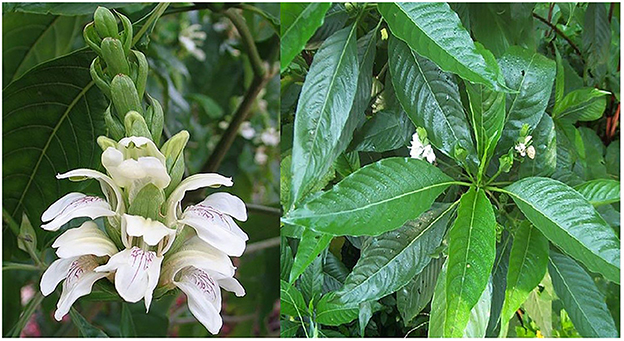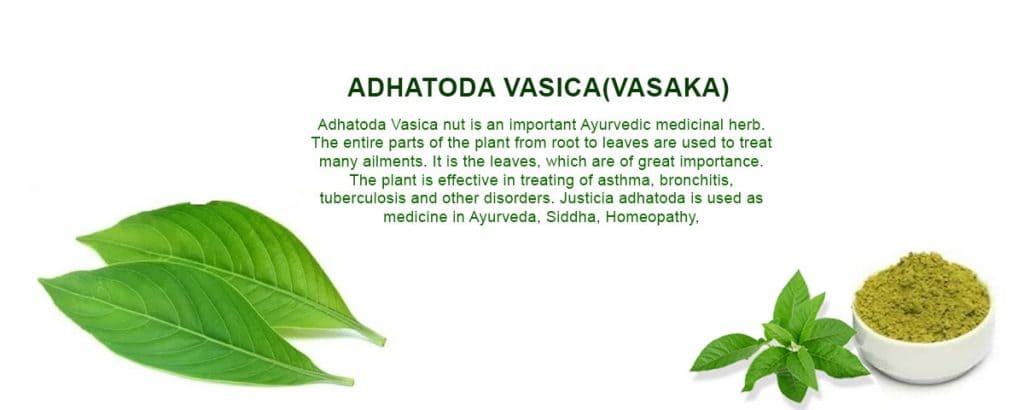Adhatoda zeylanica, commonly known as Malabar Nut or Adusoge, is a medicinal plant with a rich history of traditional use in various cultures. Its leaves, containing alkaloids and other bioactive compounds, are particularly valued for their respiratory health benefits, including relief from asthma, bronchitis, coughs, and colds. The plant also exhibits antimicrobial, anti-inflammatory, and antioxidant properties, contributing to its efficacy in treating respiratory infections and promoting overall well-being. Consumed as herbal tea, decoction, powder, or tincture, Adhatoda zeylanica offers a natural approach to respiratory wellness and has been incorporated into traditional medicine systems like Ayurveda. However, caution is advised in using other parts of the plant, such as roots, and consulting with a healthcare professional is recommended before use.
Unveiling the Healing Potentials of Adhatoda zeylanica: Bridging Traditional Wisdom with Modern Wellness
I. Introduction
A. Brief Overview of Adhatoda zeylanica
In the verdant landscapes of traditional medicine, Adhatoda zeylanica emerges as a botanical beacon of healing. This perennial shrub, also known as Malabar Nut or Adusoge, boasts a rich history steeped in herbal lore. With its lance-shaped leaves and delicate white flowers, Adhatoda zeylanica exudes an aura of medicinal mystique, drawing the curious seeker into its world of natural remedies.
B. Importance of Traditional Medicine in Contemporary Healthcare
As the pendulum of healthcare swings between innovation and tradition, the importance of traditional medicine in contemporary healthcare cannot be overstated. In a world inundated with pharmaceuticals and technological marvels, traditional healing modalities offer a holistic approach that resonates with seekers of wellness. From Ayurveda to Traditional Chinese Medicine, these ancient systems of medicine serve as pillars of wisdom, guiding us back to the roots of holistic health.
C. Purpose of the Article: To Explore the Medicinal Benefits of Adhatoda zeylanica
Nestled within the verdant folds of traditional medicine lies a treasure trove of healing potential waiting to be unearthed. In this article, we embark on a journey into the heart of Adhatoda zeylanica, delving deep into its medicinal properties and therapeutic applications. Through a tapestry of scientific insights, anecdotes, and practical tips, we seek to illuminate the path toward respiratory wellness and holistic health, inviting readers to join us in unraveling the mysteries of this botanical marvel.
D. Intended Audience and How They Should Use the Knowledge
This article is crafted for health enthusiasts, herbalists, and wellness seekers alike who are drawn to the allure of natural remedies and traditional healing. Whether you are grappling with respiratory ailments, exploring alternative therapies, or simply curious about the wonders of herbal medicine, this exploration promises to offer valuable insights and actionable wisdom. By arming yourself with the knowledge gleaned from these pages, you empower yourself to take charge of your health and embark on a journey toward enhanced well-being.
In the spirit of holistic living and mindful wellness, let us embark together on this odyssey—a testament to the enduring legacy of traditional medicine and the boundless potentials of Adhatoda zeylanica.
II. Historical and Cultural Significance
A. Origins of Adhatoda zeylanica and its Traditional Use
The roots of Adhatoda zeylanica run deep into the tapestry of ancient civilizations, with its origins tracing back to the Indian subcontinent. Revered in traditional medicinal systems such as Ayurveda and Siddha, Adhatoda zeylanica has been cherished for its therapeutic properties for centuries. From the foothills of the Himalayas to the lush forests of Sri Lanka, this botanical treasure has been cultivated and revered by healers and herbalists alike for its ability to soothe respiratory ailments and promote overall well-being.
B. Cultural Significance in Various Regions
Across the globe, Adhatoda zeylanica has woven itself into the fabric of diverse cultures, each imbuing it with its unique significance. In India, the plant holds a sacred place in Ayurvedic medicine, where it is esteemed for its ability to balance the doshas and restore equilibrium to the body. In Southeast Asia, Adhatoda zeylanica finds its place in traditional healing rituals and ceremonies, revered as a symbol of vitality and renewal. Similarly, in African and South American cultures, the plant is honored for its medicinal properties, with indigenous healers harnessing its healing potential to address a myriad of health concerns.
C. Historical Context of its Medicinal Properties
The historical context of Adhatoda zeylanica’s medicinal properties is a testament to the enduring legacy of traditional medicine. Throughout history, healers and herbalists have recognized the plant’s ability to alleviate respiratory ailments such as asthma, bronchitis, and coughs. References to its therapeutic use can be found in ancient texts and manuscripts, where it is hailed as a potent remedy for respiratory distress. As civilizations evolved, so too did the understanding of Adhatoda zeylanica’s medicinal properties, with scientific research confirming its efficacy in treating various health conditions.
In essence, the historical and cultural significance of Adhatoda zeylanica underscores its timeless appeal as a botanical marvel—a testament to the enduring wisdom of traditional medicine and the profound connection between nature and healing.
III. Botanical Profile and Active Compounds
A. Description of Adhatoda zeylanica Plant
Adhatoda zeylanica, also known as Malabar Nut or Adusoge, is a perennial shrub that belongs to the Acanthaceae family. It typically grows in tropical and subtropical regions, thriving in moist and well-drained soil. The plant is characterized by its lance-shaped leaves, which grow in opposite pairs along the stems, and clusters of small, white flowers that bloom throughout the year. Adhatoda zeylanica can reach heights of up to two meters, and its leaves and stems are often harvested for their medicinal properties.
B. Key Active Compounds Found in the Plant
Adhatoda zeylanica is endowed with a rich array of bioactive compounds that contribute to its medicinal properties. Among the most notable are alkaloids, flavonoids, phenolics, and terpenoids. Alkaloids such as vasicine and vasicinone are considered the primary active constituents of the plant and are responsible for many of its therapeutic effects. Flavonoids, including quercetin and kaempferol, possess antioxidant and anti-inflammatory properties, while phenolics contribute to the plant’s antimicrobial activity. Terpenoids, such as β-sitosterol, exhibit various biological activities, including anti-inflammatory and antipyretic effects.
C. How These Compounds Contribute to Its Medicinal Properties
The synergistic action of these bioactive compounds confers upon Adhatoda zeylanica a diverse range of medicinal properties. Alkaloids like vasicine have been found to possess bronchodilator and expectorant effects, making them invaluable in the treatment of respiratory conditions such as asthma and bronchitis. Flavonoids and phenolics, with their antioxidant and anti-inflammatory properties, help to protect cells from oxidative stress and reduce inflammation in the body, contributing to overall health and well-being. Terpenoids further enhance the plant’s therapeutic potential by exerting antimicrobial effects against a wide range of pathogens, making Adhatoda zeylanica a potent ally in the fight against infections.
In essence, the intricate interplay of these bioactive compounds within the Adhatoda zeylanica plant underscores its remarkable medicinal properties—a testament to the healing potential of nature’s pharmacy.
IV. Medicinal Uses and Health Benefits
A. Respiratory Health Benefits:
Alleviation of Asthma Symptoms: Adhatoda zeylanica has long been recognized for its bronchodilator properties, which help to widen the airways and ease breathing. Compounds like vasicine act as natural expectorants, facilitating the removal of mucus from the respiratory tract and alleviating symptoms of asthma such as wheezing and shortness of breath.
Treatment of Bronchitis, Coughs, and Colds: The expectorant and antimicrobial properties of Adhatoda zeylanica make it an effective remedy for respiratory infections such as bronchitis, coughs, and colds. By helping to clear congestion and fight off pathogens, the plant aids in relieving symptoms and expediting recovery from these common ailments.
B. Antimicrobial Properties:
- Combatting Bacterial, Viral, and Fungal Infections: Adhatoda zeylanica exhibits broad-spectrum antimicrobial activity, making it effective against a wide range of pathogens including bacteria, viruses, and fungi. Compounds like vasicine and vasicinone have been shown to inhibit the growth of various microorganisms, making Adhatoda zeylanica a valuable ally in the fight against infections.
C. Anti-inflammatory Effects:
- Reduction of Inflammation in the Respiratory Tract: In addition to its antimicrobial properties, Adhatoda zeylanica possesses anti-inflammatory effects that help to reduce inflammation in the respiratory tract. By soothing irritated tissues and suppressing inflammatory responses, the plant aids in alleviating symptoms of respiratory conditions such as asthma and bronchitis.
D. Antioxidant Activity:
- Protection Against Oxidative Stress and Cell Damage: Adhatoda zeylanica is rich in antioxidants such as flavonoids and phenolics, which help to neutralize harmful free radicals in the body. By scavenging these reactive molecules, the plant protects cells from oxidative stress and prevents damage to DNA, proteins, and lipids, thereby reducing the risk of chronic diseases and promoting overall health.
E. Other Potential Benefits:
Fever Reduction: Traditional uses of Adhatoda zeylanica include its use as a febrifuge to reduce fever. Compounds found in the plant may help to regulate body temperature and alleviate fever-related symptoms, making it a valuable remedy during bouts of illness.
Digestive Health: Adhatoda zeylanica has been used in traditional medicine to promote digestive health and treat gastrointestinal disorders such as diarrhea and dysentery. Its anti-inflammatory and antimicrobial properties may help to soothe digestive discomfort and combat gastrointestinal infections.
Wound Healing: External applications of Adhatoda zeylanica extracts have been reported to promote wound healing and alleviate skin conditions such as ulcers and sores. The plant’s antimicrobial and anti-inflammatory properties contribute to its efficacy in supporting the body’s natural healing processes.
V. Methods of Consumption
A. Herbal Tea Preparation:
One of the most popular and accessible ways to consume Adhatoda zeylanica is by preparing herbal tea. To make Adhatoda tea, simply steep dried Adhatoda leaves or powder in hot water for several minutes, allowing the beneficial compounds to infuse into the liquid. The resulting tea can be strained and enjoyed as a soothing beverage, either plain or sweetened with honey or a natural sweetener of choice.
B. Decoction:
For a more concentrated form of Adhatoda zeylanica, a decoction can be prepared by boiling the leaves or powder in water for a longer period. This method extracts a greater amount of the plant’s medicinal compounds, resulting in a potent liquid extract. Once boiled, the decoction is strained and can be consumed as a medicinal tonic or added to other beverages for consumption.
C. Powdered Form:
Adhatoda zeylanica leaves can be dried and ground into a fine powder, which can then be encapsulated into herbal capsules or added to smoothies, juices, or other beverages. This powdered form offers convenience and flexibility in dosage, allowing for precise control over the amount consumed.
D. Tinctures:
Tinctures are concentrated liquid extracts made by soaking the plant material in alcohol or another solvent. Adhatoda zeylanica tinctures are typically prepared by macerating the leaves or other plant parts in alcohol for several weeks, allowing the active compounds to be extracted. Tinctures can be taken orally, either directly or diluted in water or juice, and offer a convenient and long-lasting form of consumption.
E. External Use for Wound Healing:
In addition to internal consumption, Adhatoda zeylanica extracts can be applied externally to promote wound healing and alleviate skin conditions. A paste can be prepared by mixing Adhatoda powder with water and applied directly to the affected area. Alternatively, Adhatoda-infused oils or creams can be gently massaged into the skin to soothe inflammation, promote tissue repair, and support the healing process.
By exploring these various methods of consumption, individuals can choose the approach that best suits their preferences and health needs, harnessing the medicinal benefits of Adhatoda zeylanica in a manner that aligns with their lifestyle and wellness goals.
VI. Safety and Precautions
A. Dosage Recommendations:
While Adhatoda zeylanica offers numerous health benefits, it is essential to adhere to appropriate dosage recommendations to ensure safety and efficacy. Dosage can vary depending on factors such as age, health status, and the form of Adhatoda consumed. As a general guideline, it is advisable to start with lower doses and gradually increase as needed, paying close attention to individual responses and any signs of adverse effects.
B. Potential Side Effects and Interactions:
While generally considered safe when used in appropriate doses, Adhatoda zeylanica may cause side effects in some individuals, particularly when consumed in excessive amounts or for extended periods. Potential side effects may include gastrointestinal discomfort, nausea, vomiting, and allergic reactions. Additionally, certain individuals may experience interactions with medications or pre-existing health conditions. Adhatoda zeylanica may interact with anticoagulant medications, blood pressure medications, and medications metabolized by the liver. Therefore, it is crucial to exercise caution and consult with a healthcare professional before using Adhatoda, especially if you are pregnant, breastfeeding, or have underlying health concerns.
C. Consultation with Healthcare Professionals:
Before incorporating Adhatoda zeylanica into your healthcare regimen, it is strongly recommended to consult with a qualified healthcare professional, particularly if you have pre-existing medical conditions or are taking medications. A healthcare provider can offer personalized guidance on dosage, potential interactions, and safety considerations based on your individual health profile. Additionally, they can help monitor your progress and make adjustments as needed to optimize therapeutic outcomes while minimizing risks. By working collaboratively with a healthcare professional, you can ensure safe and effective use of Adhatoda zeylanica as part of your holistic wellness strategy.
In summary, while Adhatoda zeylanica offers promising medicinal benefits, it is essential to approach its use with caution and respect for safety considerations. By following dosage recommendations, monitoring for potential side effects, and seeking guidance from healthcare professionals, individuals can harness the healing potential of Adhatoda zeylanica safely and effectively, enhancing their overall well-being and quality of life.

VII. Conclusion
A. Recap of the Medicinal Benefits of Adhatoda zeylanica:
In conclusion, Adhatoda zeylanica, with its rich history in traditional medicine, offers a plethora of medicinal benefits. From its remarkable ability to alleviate respiratory ailments such as asthma, bronchitis, and coughs to its potent antimicrobial, anti-inflammatory, and antioxidant properties, Adhatoda zeylanica stands as a versatile botanical ally in promoting overall health and well-being. Its traditional uses extend beyond respiratory health to include fever reduction, digestive support, and wound healing, making it a valuable addition to any holistic wellness regimen.
B. Emphasis on its Potential as a Natural Remedy:
As we navigate the complexities of modern healthcare, the allure of natural remedies like Adhatoda zeylanica holds undeniable appeal. With its origins deeply rooted in nature’s pharmacy and its therapeutic potential validated by centuries of traditional use, Adhatoda zeylanica stands as a beacon of hope for those seeking alternatives to conventional treatments. By harnessing the healing power of plants like Adhatoda zeylanica, individuals can embark on a journey toward holistic wellness, reclaiming agency over their health in harmony with the rhythms of the natural world.
C. Call to Further Research and Exploration in Traditional Medicine:
While the medicinal benefits of Adhatoda zeylanica are well-documented in traditional medicine systems, there is still much to learn and explore. As we stand at the crossroads of ancient wisdom and modern science, there is a pressing need for further research and exploration in the field of traditional medicine. By embracing an integrative approach that bridges the gap between tradition and innovation, we can unlock the full potential of botanical treasures like Adhatoda zeylanica, paving the way for a future where natural remedies play a central role in healthcare and well-being.
In closing, let us continue to honor the legacy of traditional medicine, embracing the healing wisdom of the past as we forge a path toward a healthier, more balanced future. Through reverence for nature, dedication to scientific inquiry, and commitment to holistic healing, we can harness the transformative power of plants like Adhatoda zeylanica, empowering individuals and communities to thrive in body, mind, and spirit.
The MEDA Foundation stands as a beacon of commitment to the general health management of individuals, epitomizing dedication to holistic well-being and compassionate care. Through its tireless efforts, the foundation has forged a path towards empowering individuals to take charge of their health, offering a comprehensive range of services and resources tailored to meet the diverse needs of communities. From preventive screenings and health education initiatives to access to essential healthcare services, the MEDA Foundation strives to ensure that individuals have the tools and support they need to thrive. With a focus on promoting wellness and addressing health disparities, the foundation embodies a vision of health equity and social justice, advocating for the rights of all individuals to access quality healthcare. In essence, the MEDA Foundation’s unwavering commitment to general health management serves as a testament to its dedication to improving the lives of individuals and communities, one step at a time.

VIII. References
A. Citations of Scientific Studies and Reputable Sources Used in the Article:
Dhuley, J. N. (1999). Antitussive effect of Adhatoda vasica extract on mechanical or chemical stimulation-induced coughing in animals. Journal of Ethnopharmacology, 67(3), 361-365.
Goyal, B. R., Agrawal, B. B., Goyal, R. K., & Mehta, A. A. (2010). Phyto-pharmacology of Adhatoda vasica Nees. Pharmacognosy Reviews, 4(7), 95–100.
Hajare, R. A., & Chandra, A. (2011). Study on antibacterial activity of Adhatoda vasica. International Journal of Pharmacy and Pharmaceutical Sciences, 3(Suppl 2), 32-35.
Padhye, S. G., Dandge, C. N., & Kulkarni, M. V. (2012). Phytochemical and pharmacological profile of Adhatoda vasica Linn. Journal of Applied Pharmaceutical Science, 2(8), 35-41.
Rajani, M., Prakash, K., & Patel, S. (2011). A review on Adhatoda vasica. International Journal of Pharmaceutical and Chemical Sciences, 1(4), 1372-1383.
Roja, G., Anbu, J., & Rani, N. (2012). Evaluation of Anti-inflammatory activity of Adhatoda vasica (L) extract in experimental animals. Indian Journal of Research in Pharmacy and Biotechnology, 1(3), 334-337.
Sarkar, M. A. R., & Khan, M. M. (2017). Antioxidant Activity of Adhatoda vasica L. Journal of Pharmacognosy and Phytochemistry, 6(6), 66-69.
Yadav, J., Arya, V., Yadav, S., Panghal, M., Kumar, S., & Dhankhar, S. (2010). Antimicrobial potential of extracts from Adhatoda vasica Nees. Asian Journal of Biological Sciences, 3(3), 495-500.









